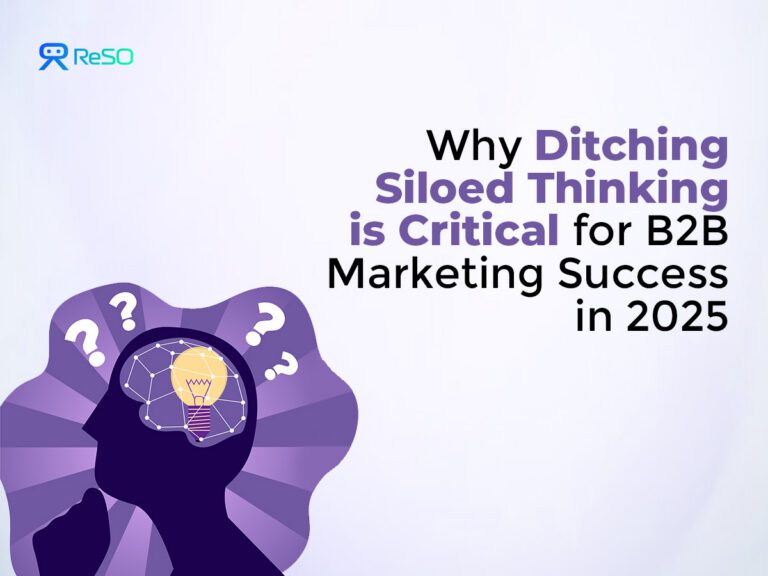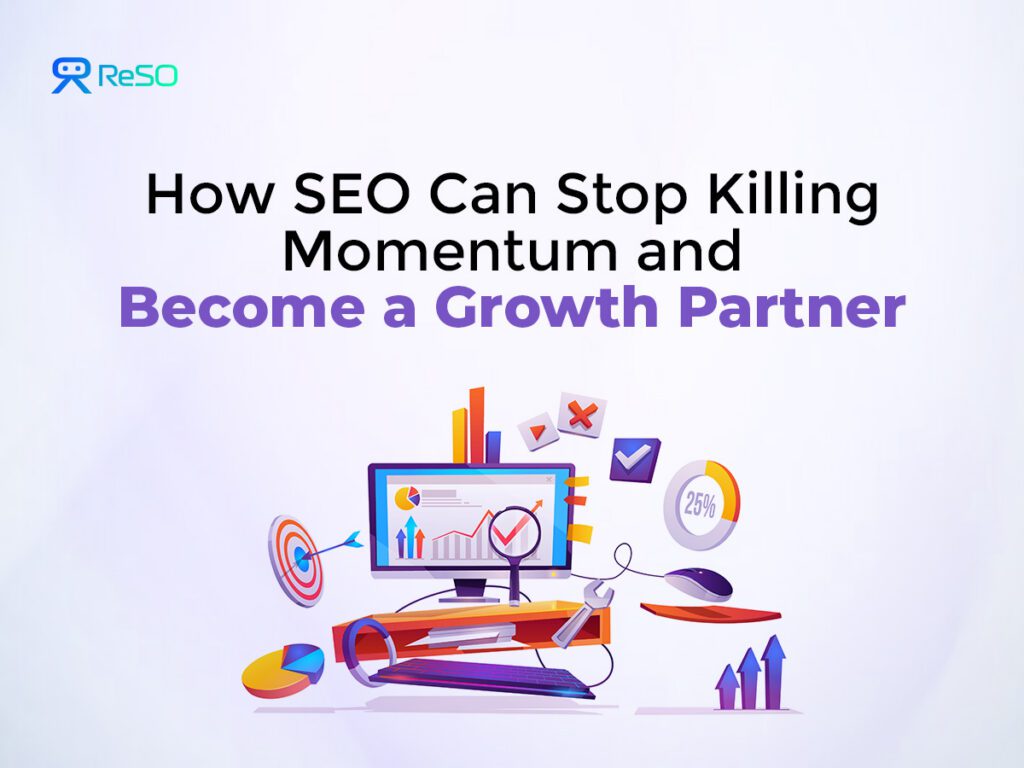Siloed thinking has been a stubborn problem in B2B marketing and sales long before AI and LLMs reshaped the universe. Departments working in isolation, chasing their own targets, and using disconnected data sets often lead to duplicated effort and inconsistent customer experiences. If your marketing and sales, content and paid media, or analytics and creative teams operate like islands, your growth will stall.
But why does siloed thinking persist? And more importantly, why does ditching silos matter even more today?
Key Stats
- Siloed thinking between marketing, sales, and other teams causes wasted time, data confusion, and a fragmented buyer experience, slowing growth.
- Silos often form naturally due to unclear roles, dominant sales culture, and lack of shared data, but they’re a revenue killer.
- An integrated ecosystem with content as the trust engine, paid media as the amplifier, AI tools as curators, and metrics as guardrails is the winning strategy.
- Real companies like SAS Viya and Maersk prove that aligning teams, messaging, and channels drives higher engagement, brand perception shifts, and lower costs.
- Breaking silos starts with shared goals, centralized data, cross-team communication, validated messaging, and aligned KPIs focused on actual business outcomes.
The Cost of Siloed Thinking
Silos cause wasted time, friction, fragmented customer journeys, and ultimately lost revenue. When marketing and sales teams don’t share information or align strategy, it creates multiple bottlenecks:
- Data discrepancies: One team’s data conflicts with another’s, leading to confusion and poor decisions.
- Inefficient processes: Without integration, duplicate work slows progress, causing frustration and stagnation.
- Disjointed customer experience: Messaging that isn’t aligned confuses buyers and weakens your brand.
- Misaligned objectives: Sales might focus solely on quota while marketing chases vanity KPIs like MQLs, setting teams up to work against each other.
- Loss of trust internally: Finger-pointing replaces collaboration, and momentum dies.
The stark reality: organizations with fragmented teams grow more slowly and lose more customers.
Why Siloes Flourish in B2B Companies
Silos often aren’t created by ill will but by natural organizational growth and unclear roles. Sales-led growth models often place sales as dominant, and marketing becomes a support function producing collateral rather than driving revenue. Junior marketers underpowered by undefined roles reinforce the perception that marketing is a “nice to have,” not a revenue driver.
Teams run campaigns on different audiences, geographies, or ICPs without shared targeting frameworks. Messaging is often broad and unvalidated, causing disconnects between ad copy, landing pages, and sales conversations.
Without shared technology and data infrastructure, each team develops its own view of performance and pipeline. Fear and protectiveness around customer relationships create an unwillingness to share contacts or collaborate.
Breaking out of this cycle requires leadership, new investment, and defining a clear marketing role aligned with sales.
The Modern Marketing Ecosystem: How to Break Silos and Win
Siloed, disconnected marketing and sales won’t cut it in 2025. The rapid rise of AI, LLMs, and multi-channel discovery only amplifies the need for connected ecosystems.
An ecosystem approach looks like this:
- Content as the trust engine: Thoughtfully crafted to meet buyers wherever they are, address objections, and build credibility.
- Paid media as the amplifier: Spreading the trusted content beyond organic reach, driving retargeting, and momentum.
- Large Language Models as the curators: Optimizing content for AI discovery and synthesis, ensuring visibility on new search and research platforms.
- Metrics as the guardrails: Guiding investment, tracking multi-channel engagement, and optimizing continuously.
| ASPECT | SILOED THINKING | INTEGRATION |
| Team Collaboration | Teams work in isolation with minimal communication | Shared goals and regular cross-team communication |
| Data Sharing | Fragmented, inconsistent or inaccessible data | Centralized data platforms with real-time visibility |
| Customer Experience | Disjointed, inconsistent messaging and touchpoints | Seamless, consistent buyer journey across channels |
| Goals & Metrics | Separate objectives causing conflicting KPIs | Unified metrics aligned to revenue and customer outcomes |
| Marketing & Sales Alignment | Lack of alignment, misqualified leads | Joint playbooks, aligned targeting, and lead handoff |
| Workflow Efficiency | Inefficient with duplicated effort and friction | Streamlined workflows increasing speed and accuracy |
| Internal Culture | Fragmented teams, finger-pointing, low morale | Collaborative, accountable, and motivated teams |
| Impact on Growth | Slower revenue growth, higher churn | Faster growth, improved customer retention |
Step 1: Create Shared Goals and Unified Customer Journey
Start by defining shared revenue and engagement goals across teams. Map the customer lifecycle end-to-end, identifying exactly where leads transition between marketing and sales.
Everyone in marketing and sales should understand the customer’s experience at every stage. Demolish walls between teams by building process overlays that describe roles clearly and handoff criteria precisely.
Step 2: Centralize Data and Technology
Invest in tools like CRM and CDP platforms that integrate and offer real-time visibility across teams. When sales, marketing, and customer success access the same dashboards based on agreed KPIs, communication improves and data discrepancies are minimized.
Step 3: Establish Regular Cross-Team Communication
Set up frequent sync meetings and shared communication channels. These touchpoints create a culture of transparency and collective problem-solving.
Step 4: Validate Marketing Messages with the Right Audience
Use platforms like Wynter to continuously test messaging with your ICP. Targeted, validated messaging drives up to 73% more demos and signups, compared to generic messaging.
Step 5: Align KPIs and Reward Collaboration
Instead of celebrating MQL volume alone, measure marketing’s impact on closed deals. Sales success depends on marketing’s pipeline influence; both sides must feel accountable for the same outcomes.
Real-World Success Stories
SAS Viya
By aligning content, paid media, and sales efforts on LinkedIn, SAS Viya increased engagement rates by 31%, reached 9 million new buyers, and reduced cost per lead by 28% in six months. This success highlights how cohesive ecosystems amplify impact.
Maersk
A cinematic, human-centered campaign repositioned Maersk’s brand from “shipping company” to “integrated logistics provider,” shifting perception in 54% of their audience. Careful messaging, aligned paid and organic efforts, and collaboration with sales drove this transformative shift.
Why This Matters More Than Ever
B2B buyers don’t experience brands as silos. They explore across web, sales, social, and AI-powered discovery.
Fragmented marketing is invisible or confused in this landscape.
What buyers crave is a seamless, trustworthy, relevant experience.
Only aligned revenue teams delivering connected messages and coordinated action can provide that.
The Data-Backed Edge of Breaking Silos.
- Integrated marketing and sales teams report up to 31% higher engagement rates and significantly better pipeline velocity.
- Integrated marketing using full-funnel strategies: targeted ads at awareness, consideration, conversion, and loyalty stages, increased sales, repeat purchases, new-to-brand buyers, and revenue across markets.
Ready to Break Your Silos for Good?
- Start small. Define shared goals for one key product line or campaign.
- Pilot joint marketing and sales teams with clear playbooks.
- Invest in technology and processes that unify data & communication.
- Build a culture that celebrates collaboration and shared success.
Siloed thinking is the hidden tax draining B2B growth. Breaking silos unlocks clarity, speed, and impact.
Today’s buyers demand seamless, trusted, aligned experiences. Marketers and sales must unite to deliver that. The ecosystem approach: combining content, paid media, AI curation, and data-driven guardrails, is your blueprint for success.Make no mistake: the future rewards those who ditch silos and win together. And if you’re ready to ditch siloes, and invest in the future of your B2B brand reaching new customers through AI Search Results, book a call with us now.








